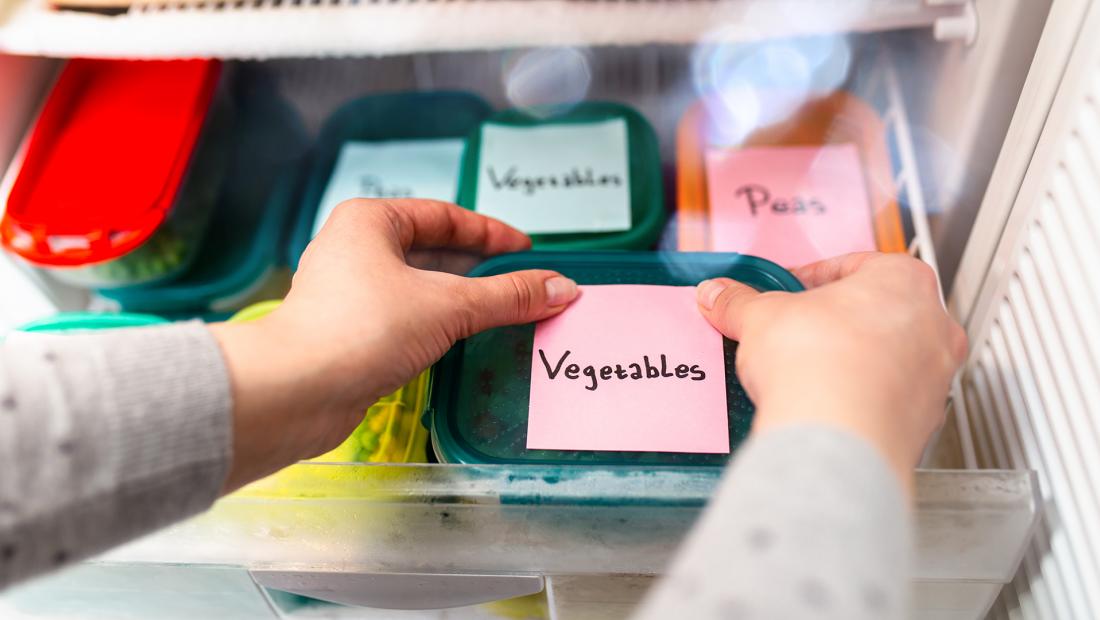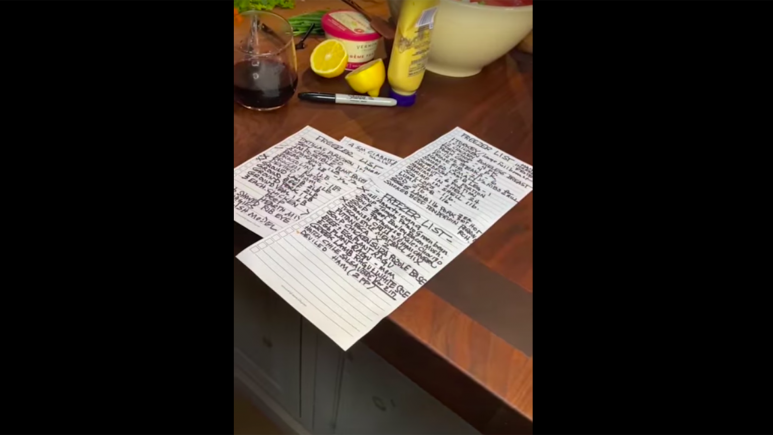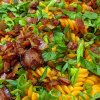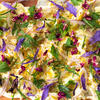
Now more than ever, a lot of us are staying home, avoiding unnecessary runs to the grocery store and cooking at home as we practice social distancing amid the coronavirus outbreak. Because of that, refrigerators and pantries are being stuffed to full capacity, and food's become the equivalent of edible gold.
That’s why it's more important than ever to stretch every ingredient, especially if you overbought. And we're here to help make sure nothing ends up wasted in the trash!
The good news? Almost anything can be frozen. From bread, milk and eggs to veggies, meat, fruit and more, you'll be amazed by how many items in your kitchen have a second life in their future.
The biggest difference between a refrigerator and freezer—besides their temperature—is what it does to your food. Like most things that age, food loses moisture and just gets a little older with time—when you toss something in the refrigerator, you're slowing down that "aging" process. A freezer, on the other hand, essentially freezes your food at that moment in time.
Here are tips on how popular household foods freeze—just remember to use a sharpie to date each frozen good.
How to freeze a loaf of bread:
If you plan on using it within the next month, chuck store-bought sliced sandwich bread into the freezer—bag, plastic tie and all. Each bread slice can be pried off gently while still frozen—use a butter knife to loosen, if needed—and toasted immediately or left to thaw, which only takes minutes. If you plan on keeping the bread in the freezer for longer than a month, double-wrapping will help keep it fresher for longer.
For uncut, fresh loaves of bread, wrap the loaf tightly in aluminum foil, then double-wrap in plastic wrap. To reheat the bread, remove and discard the plastic wrap, then gently unwrap the foil, and sprinkle the loaf all over with water before carefully rewrapping in the foil. Bake in a preheated oven, between 350˚F to 400˚F, until softened throughout, which will take anywhere from 20 to 45 minutes, depending on the size and thickness of the loaf—just give it a squeeze while wearing oven mitts; if it's soft, it's ready.
How to freeze a gallon of milk:
Milk freezes well and just needs to thaw in the refrigerator until ready to use. However, be sure to date the carton, as it should be thawed no more than three months after being frozen.
How to freeze eggs:
Crack eggs into a bowl, then beat them and freeze in containers suitable for your household's size. Once you thaw eggs, you'll want to use them soon, so don't freeze a quart-container's worth of eggs, unless using a thawed quart-container's worth is feasible for your household! Another trick worth trying is to freeze the beaten eggs in ice cube trays—once frozen, pop the cubes into a freezer bag, so you can grab and thaw what you need.
How to freeze meat:
Meat that's been purchased shrink-wrapped or vacuum-packed can be thrown into the freezer as is—just remember to date it, use it within three to six months, and thaw it in the refrigerator in a plastic bag to contain any juices that escape while defrosting.
If the meat is loosely-packed in butcher paper, it's also fine to freeze it as is, but as the packing is likely to be more porous, keep it within eyesight in the freezer as a visual reminder to use it soon, or take the time to double-wrap it in another layer of plastic wrap and date it.
For large economy packs, separate the meat into quantities suitable for your family, then double-wrap and date before freezing.
How to freeze vegetables:
If you're wondering if it's possible to freeze fresh vegetables before they go bad, the answer is yes—but with a caveat. Cooking the vegetables first—whether in a finished dish or simply blanched—keeps them from breaking down into a pile of mush once thawed for reuse. This applies to veggies like Brussels sprouts, beets and turnips. Rach likes to freeze tomatoes, broccoli and green beans: "I use [frozen tomatoes] in everything. Homemade sauces, soups, stews, put them through a food mill and turn them into sauce." And for her greens, Rach likes to keep them tender-crisp. "Drop them into salted water for two minutes, cold shock them, dry them completely, then pop them into your food storage bags," she says. Try blanching any produce you'd like simply cooked, but for any veggies you like sautéed or roasted—like asparagus, Brussels sprouts or mushrooms—cook them however you prefer and then freeze.
And remember: the more water in a vegetable, the less likely it is to freeze well solo. Zucchini, celery, eggplant and potatoes aren't good candidates for freezing raw or blanched, but freeze them as a puree, vegetable soup, baba ganoush or potato gratin and you'll be surprised by how well they reheat.
Hearty winter greens—think swiss chard, collard greens or cabbage—freeze well once prepped and blanched. (Pro Tip: Freezing them raw will work, but their texture is likely to change, especially the longer they sit. However, they're excellent additions to green smoothies.)
How to freeze oranges:
All citrus juice and grated zest freezes well, but for whole oranges, try this trick: Peel the orange, removing as much of the white pith as possible. Divide the orange into quarters, then freeze the quarters. Once frozen, transfer the quarters into a freezer bag. Defrost the orange quarters as needed.
How to freeze tofu:
Slice tofu into about ¾-inch slabs, then freeze on a baking sheet. Once frozen, transfer to a freezer bag. Thaw as needed in a colander to drain, and press gently to remove any excess liquid before using.
How to freeze fresh ham:
Slice or chop the ham into quantities and shapes (sliced, cubed or finely chopped) suitable for your needs, then store in freezer-safe bags, expelling all air possible, and date it. Freeze and use within three months.
How to freeze green peppers:
Prep the green peppers so they're ready to use (cored, seeded, chopped or sliced), then store in a freezer-safe bag, expelling all the air. Freeze and use within a month.
How to freeze lunch meat:
Store-bought vacuum-packed lunch meat can be frozen as is for up to three months. For deli-sliced meat, double-wrap in plastic wrap before freezing and use within a month.
How to freeze mushrooms:
Wipe mushrooms clean with a paper towel—you don't want the mushrooms to absorb water from being rinsed—then arrange on a baking sheet and freeze. Once frozen, transfer to freezer-safe bags and suck out any excess air by pressing gently or even sealing the bag around a straw and sucking out all the air before sealing completely. The mushrooms will be fragile once frozen, so if concerned about them retaining their shape, store the freezer bag in a container for an extra-layer of protection.
How to freeze fresh fruit:
After cleaning and drying fruit, either freeze whole on a baking sheet or prep as needed before freezing. Transfer to freezer bags before storing.
How to freeze fish:
Wrap fish in individual or family-sized portions, then wrap in wax or parchment paper, then double-wrap tightly in plastic wrap. Date it, then freeze. Use within a month.
How to freeze nuts and grains:
Chefs and food pros alike also tend to store ingredients like nuts and grains in their freezer. "I always keep my breadcrumbs and nuts in my freezer," Rach says. "You get a nice long shelf life. The breadcrumbs won't get stale or buggy on you and the nuts won't spoil. Nuts are full of oil, so if you keep them in the freezer, you get your longest shelf life out of them." Rach's same tip also applies to grains and specialty flours, which can turn after sitting in a pantry for too long.
How to freeze cheese:
While Rach says she doesn't freeze cheese often (she pretty much only sticks to freezing shredded cheeses that she might throw in an omelette), in a pinch, fresh varieties—like mozzarella and goat cheese—can be frozen for up to two months. Hard cheeses, like parmigiano-reggiano or pecorino romano, will keep for weeks refrigerated, but save any rinds in the freezer to drop into a soup for an umami-hit of flavor.
Avoid freezing ricotta, soft ripened cheeses and semi-soft cheeses, which might crumble, Rach says.
Considering no one wants to waste any food now if possible, toss just about any perishable that's likely to reach the end of its shelf life before you're ready to eat it into the freezer. Try to use it within a month or two, as the sooner you use it, the less likely it will have any freezer burn or other changes that will affect taste. Let it thaw in the refrigerator on a plate or in a plastic bag to collect any liquid that collects as it defrosts.
HOW DO I PACKAGE FOOD BEFORE FREEZING IT?
The way food is wrapped and stored in the freezer will affect the outcome. Air and water are frozen goods' worst enemies and will result in freezer burn, which drastically affects flavor. So press out or remove any air possible when using freezer bags, or wrap tightly in foil and then plastic wrap, which also limits the amount of exposure to air. "Double-wrapping anything keeps it fresher longer," adds Rach.
Freezing foods so they lay flat will help maximize freezer space. "When it comes to freezing food, flat is best," Rach says. "Don't clutter up your freezer with lots of big clunky plastic food containers." This applies to soups and stews, which Rach will often store in a freezer-friendly resealable plastic bag before freezing flat on a baking sheet.
Frugal YouTube star Jordan Page is a big fan of freezing foods in individual portions. Her surprise tip is to try this with mashed potatoes, and this also applies to pasta bakes and even risotto—which makes them easier to use while still frozen. She'll freeze portions on a baking sheet, then pop them into a freezer bag for space-saving storage. Rach uses the same trick when it comes to meat and fish: "Buy a few pounds, then individually wrap the chicken, the fish, the steak, then put them in a larger freezer bag so you can pull out one portion at a time."
HOW LONG DOES FOOD KEEP IN THE FREEZER?
There's a general restaurant rule that calls for first in, first out, which is a good principle to apply to all food ongoings in your household, including your freezer. Just because it's frozen doesn't mean it won't ever change—once again, beware of dreaded freezer burn—so keep your goods organized by category so you know what you have at a glance.
Rach has a clever process for keeping track of what's in her freezer.
"Every single thing I cook ahead or process in any way and freeze, I keep track of on a main list," Rach shares in a video of her cooking chicken pot pie in her home kitchen (with hubby John behind the camera). "When I use the food, I put a full X. If I use half of a product, I put half an X."

Keep in mind that bread freezes well, but it also tends to change flavor when left to perish, forgotten in a freezer — so try to use it within a few months. Store-bought frozen produce has been packaged and prepared to maintain a decent shelf life, but homemade batches of frozen produce or leftovers will likely have a shorter shelf-life and should be kept up front to keep them from being forgotten—and wasted!
Another exception here is that foods loaded with fat or oils will keep better than most. This applies to croissants, pesto, meat sauce, and even butter itself.
HOW TO FREEZE LEFTOVER PIZZA + MORE TAKEOUT
If you've ordered takeout and find yourself with leftovers, consider the possibilities: Pizza can be split into individual slices, stacked with sheets of wax paper and double-wrapped. Leftover sauces can be saved for adding flavor to a future dish or to even fortify broth for a soup. And the onions or chili peppers leftover from Chinese take-out? They're also ideal flavor boosters for soup or fried rice.
Even stale bread is worth saving—cut into cubes and freeze for a future strata or bread pudding. And if you forgot to finish last night's wine, pour it into a container and freeze for the next time you need a splash or save the remnants until you have enough for a stew. Once you start freezing, you'll find it hard to stop, spotting little flavor boosters everywhere.


